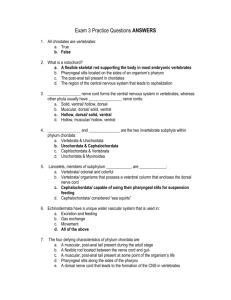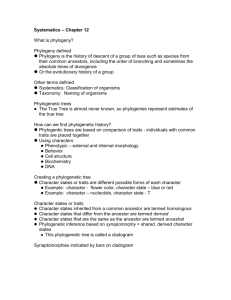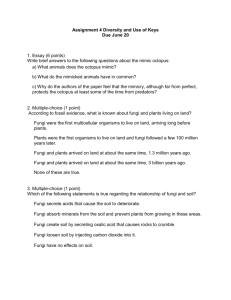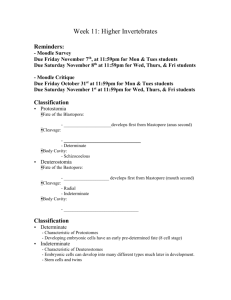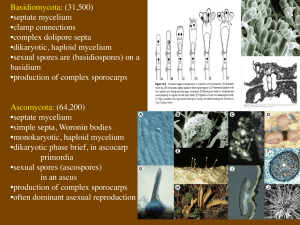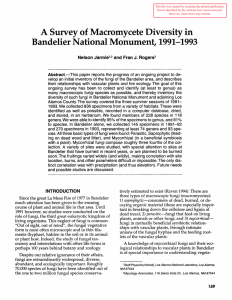Tree of Life Assignment
advertisement
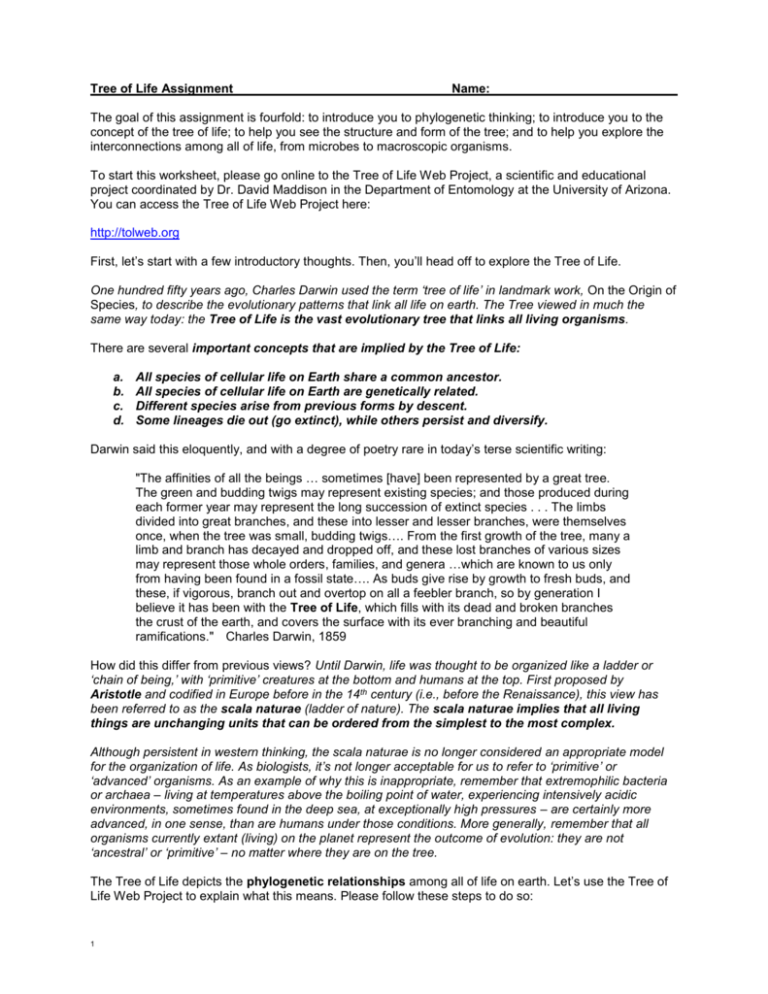
Tree of Life Assignment Name: The goal of this assignment is fourfold: to introduce you to phylogenetic thinking; to introduce you to the concept of the tree of life; to help you see the structure and form of the tree; and to help you explore the interconnections among all of life, from microbes to macroscopic organisms. To start this worksheet, please go online to the Tree of Life Web Project, a scientific and educational project coordinated by Dr. David Maddison in the Department of Entomology at the University of Arizona. You can access the Tree of Life Web Project here: http://tolweb.org First, let’s start with a few introductory thoughts. Then, you’ll head off to explore the Tree of Life. One hundred fifty years ago, Charles Darwin used the term ‘tree of life’ in landmark work, On the Origin of Species, to describe the evolutionary patterns that link all life on earth. The Tree viewed in much the same way today: the Tree of Life is the vast evolutionary tree that links all living organisms. There are several important concepts that are implied by the Tree of Life: a. b. c. d. All species of cellular life on Earth share a common ancestor. All species of cellular life on Earth are genetically related. Different species arise from previous forms by descent. Some lineages die out (go extinct), while others persist and diversify. Darwin said this eloquently, and with a degree of poetry rare in today’s terse scientific writing: "The affinities of all the beings … sometimes [have] been represented by a great tree. The green and budding twigs may represent existing species; and those produced during each former year may represent the long succession of extinct species . . . The limbs divided into great branches, and these into lesser and lesser branches, were themselves once, when the tree was small, budding twigs…. From the first growth of the tree, many a limb and branch has decayed and dropped off, and these lost branches of various sizes may represent those whole orders, families, and genera …which are known to us only from having been found in a fossil state…. As buds give rise by growth to fresh buds, and these, if vigorous, branch out and overtop on all a feebler branch, so by generation I believe it has been with the Tree of Life, which fills with its dead and broken branches the crust of the earth, and covers the surface with its ever branching and beautiful ramifications." Charles Darwin, 1859 How did this differ from previous views? Until Darwin, life was thought to be organized like a ladder or ‘chain of being,’ with ‘primitive’ creatures at the bottom and humans at the top. First proposed by Aristotle and codified in Europe before in the 14th century (i.e., before the Renaissance), this view has been referred to as the scala naturae (ladder of nature). The scala naturae implies that all living things are unchanging units that can be ordered from the simplest to the most complex. Although persistent in western thinking, the scala naturae is no longer considered an appropriate model for the organization of life. As biologists, it’s not longer acceptable for us to refer to ‘primitive’ or ‘advanced’ organisms. As an example of why this is inappropriate, remember that extremophilic bacteria or archaea – living at temperatures above the boiling point of water, experiencing intensively acidic environments, sometimes found in the deep sea, at exceptionally high pressures – are certainly more advanced, in one sense, than are humans under those conditions. More generally, remember that all organisms currently extant (living) on the planet represent the outcome of evolution: they are not ‘ancestral’ or ‘primitive’ – no matter where they are on the tree. The Tree of Life depicts the phylogenetic relationships among all of life on earth. Let’s use the Tree of Life Web Project to explain what this means. Please follow these steps to do so: 1 I. At the ToLWeb home page (tolweb.org), you will see a conceptualization of the tree in the center of the page. Below that, you’ll see some text that starts with ‘The Tree of Life Web Project (ToL) is a collaborative effort…”. In that paragraph, click on ‘phylogeny’. II. You will be taken to a page that starts with the title ‘What is phylogeny?’. Answer the following based on the text on this page: 1. What is meant by ‘the phylogeny of organisms’? 2. Where on the tree (trunk, branches, leaves) are the living species that we see today? 3. Look at figure 2. What do those shaded boxes at the branching points represent? 4. What kind of organism is thought to have been the shared ancestor of beetles and humans? 5. Is that exact creature – that common ancestor of beetles and humans – still alive today? 6. More generally, are ancestors of currently extant organisms ever at the tips of the tree? Are they alive today? 7. About how many leaves are there on the great Tree of Life (estimated by scientists; wide range)? Now, let’s return to the homepage for the Tree of Life Web Project (tolweb.org). Click on the Amanita muscaria on the tree, and you’ll go to the page for the Fungi. Right away, you’ll note that this tree differs in several key ways from the Hibbett et al. tree, which we’re using as our classification framework. 8. List/describe five major differences between this tree (which has not been updated to reflect the Hibbett classification) and the tree shown in Hibbett et al. (2007). 9. What's meant by the striated/striped branch(es) on the trees on the ToL Web Project? Now, click on the arrow at the base of the tree. You’ll go to the Eukaryote page. 10. What other organisms are Opisthokonts? 11. Click on one of the active links within the Opisthokont clade. Which group did you choose, and what did you learn on reading the resulting page? Return to the Eukaryote page, and click on the arrow at the base of the tree. This takes you to the ‘Life on Earth’ page, and you can see the four domains of life. Explore a bit – check out the diversity of genomic architecture of the viruses, for example. You’ll see that the non-Eukaryote domains are under-represented here – alas – but hopefully that will change in the years to come. Now return – by clicking Eukaryotes, then Fungi – to the fungal page. Note that we don’t have much information here for the new phyla – the Neocallimastigomycota or the Blastocladiomycota – nor for the Chytridiomycota. However, the pages for the “Zygomycota” – and for the phyla Glomeromycota, Basidiomycota, and Ascomycota – are rich with information. Let’s explore the Glomeromycota page. 12. How many species are currently recognized in the phylum? 13. The page lists four major characteristics of the phylum. Which of these is a shared, derived characteristic unique to the Glomeromycota? 2 14. If you were teaching Advanced Mycology, what five points would you choose to emphasize about the phylum in your lecture on the Glomeromycota? (Take your pick; what do you want to remember about this phylum?) 15. Based on this page and on our lecture notes, how could you differentiate the Glomeromycota from their former home in the genus Endogone (Endogonales)? 16. What characteristics would a member of the Glomeromycota share with Endogone? Now, please navigate back to the Fungi, and have a look at the Basidiomycota. We’ll discuss the latest perspectives on the phylogeny of the group in class on Thursday and thereafter, but in the meantime, have a look at the three major subphyla listed here. Let’s start with the Pucciniomycotina. 17. How many species of Pucciniomycotina are currently recognized? 18. What are some striking/memorable characteristics of the Pucciniomycotina? (List three). Unfortunately we don’t have too much information on the various classes within the subphylum Pucciniomycotina. However, you can find some information on the class Pucciniomycetes. Within that class, check out the totally cool order Septobasidiales. 19. What’s distinct about the Septobasidiales/Septobasidiaceae? 20. Often, the Pucciniomycotina are referred to as the rust fungi. Is this appropriate? Why or why not? Return now to the Basidiomycota, and check out the Ustilagomycotina. 21. How many species in the Ustilagomycotina are currently recognized? 22. What are three striking/memorable characteristics of the subphylum? Finally, return to the Basidiomycota and check out the Agaricomycotina – the subphylum that has inspired many to become mycologists. 23. How many species of Agaricomycotina are recognized presently? 24. Click on the lineage that is sister to the Agaricomycetes (and name that lineage here). 25. What is the sister group of the Tremellomycetes? Now, click on the class Agaricomycetes. Most of the orders shown on the Agaricomycetes tree don’t have much information attached to them. Browse around and enjoy the pictures, though – and then zoom in on the subclass Agaricomycetidae, which are depicted here as containing three orders. Click on the Agaricales, and you’ll see a fairly current depiction of the relationships among the (many) recognized families of the Agaricales. 26. How many species of Agaricales are currently known? 27. What are three striking characteristics of the Agaricales? Now, navigate back to Fungi and have a look at the Ascomycota. Let’s start with the subphylum Taphrinomycotina. We recognize this as a monophyletic lineage, but we don’t know the relationships among the classes it contains. 28. What’s the phylogenetic term for the branching pattern within the Taphrinomycotina? Now, let’s check out the (newly posted, as of last week!) subphylum Saccharomycotina. 3 29. List three striking features of the subphylum. Return to the Ascomycota, now, and please click on the Pezizomycotina. 30. Within the Pezizomycotina, what subclass contains the majority of the lichenized fungi? Three classes in the Pezizomycotina have pages with terrific descriptions of their diversity, ecology, and phylogenetic relationships: the Dothideomycetes, the Sordariomycetes, and the Leotiomycetes. Together these comprise the majority of the species diversity of the non-licheninzed Ascomycota and the majority of the phylum’s plant pathogens (and endophytes!). Because these classes are so charismatic, they’ve gotten a lot of attention from mycologists over the years. Each class formerly went by a different, non-phylogenetic name. 31. What’s the former name of the group now known as the class Sordariomycetes? 32. Name an interesting sordariomycete. Why is it interesting? 33. What’s the former name of most of the group now known as the class Dothideomycetes? 34. Name an interesting dothideomycete. Why is it interesting? 35. What’s the former name of the Leotiomycetes? 36. Note that the Leotiomycetes include the powdery mildews, an important group of plant pathogens (Erysiphales). Name another order of plant pathogens (and endophytes, and saprotrophs) in the Leotiomycetes. Using the various pages for these classes, and other references as needed, distinguish between the following: 37. Unitunicate and bitunicate asci – and give an example of an order that has one or the other. Name the class containing each order. 38. Ascolocular vs. ascohymenial development – and give an example of an order that has one or the other. Name the class containing each order. 39. Apothecium vs. perithecium – and give an example of an order that has one or the other. Name the class containing each order. 40. Finally, each of you had a focal fungus (or Fungus) on your first day of class. Starting at the root of the tree of life, navigate as far as you can to reach your organism. Tell me how far you can get by listing the taxonomy. For example, with the fungus Ganoderma oregonensis, I started at the root of the tree and navigated like this: Life on earth Eukaryotes Fungi Agaricomycotina Agaricomycetes Polyporales as far as I could go. A few closing thoughts: Hopefully, this assignment has helped you to engage in (1) some updates in the world of mycology, (2) the phylogenetic structure underlying cellular life, and the phylogenetic context and framework of the Fungi, and (3) some great photos and information about various fungal groups. Needless to say, the tree needs to be filled in – leaf pages for fungi, ‘treehouses’ for fungal groups, ecological information, etc. all are needed. We have a good start – with much to be done! Feel free to append any thoughts here. And of course, use this as an opportunity to explore the tree of life’s other components – the squids, fish, jumping spiders…and so on…are spectacular! 4

